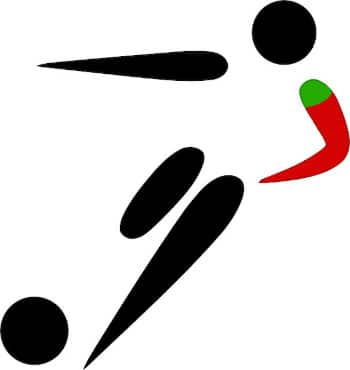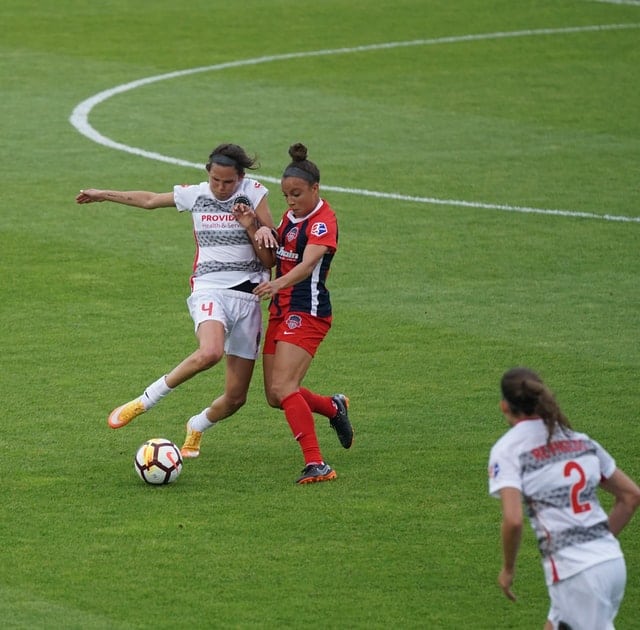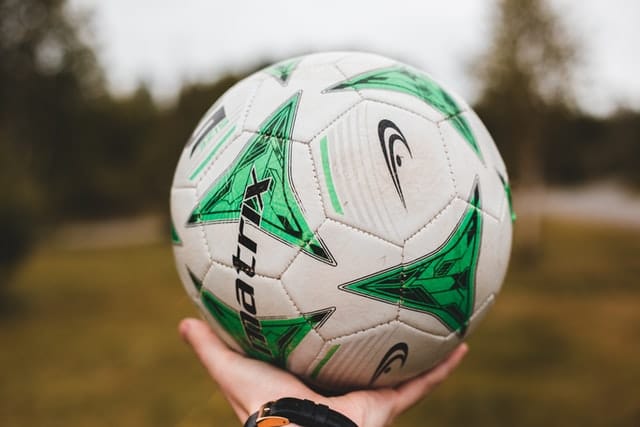If this is one thing that you should know about soccer as a complete beginner, it’s that a player can’t touch the ball with their hands while the game is on.
There are a few exceptions to this rule. For example, a goalkeeper is allowed to touch the ball with their hands when they are inside the penalty area, but In general, no outfield soccer player can use their hand to touch the ball.
But the question becomes…
What really happens if a player uses their hands in soccer?
If an outfield soccer player touches the ball with their hands while the game is on, then the opponent team is either awarded a free kick or a penalty kick depending on where the player was standing on the field when they touched the ball with their hand.
So in other words, a handball is treated like any other foul in soccer. The moment an outfield player touches the ball with their hands, the main referee of the game blows their whistle to stop the game and reward the opponent team with the proper set piece.
The main 2 things you should know are the following:
- If you touch the ball with your hands while standing outside of the penalty area of your team, then your opponent gets a direct free kick.
- If you touch the ball with your hands while standing inside the penalty area of your team, then your opponent gets a penalty kick.
Using your hands in soccer is not just limited to touching the ball with your hands. For example, some players use their hands to slightly push their opponent and for various other reasons. We’ll be discussing these scenarios too in the next few questions in this article.
Do soccer players get punished for a handball?
The only way a referee can punish a player on the field is by either giving them a yellow card or a red card if they do something that requires them to get punished.
Referees can also use verbal warnings but these warnings do not affect the player at all.
Now back to the handball. As mentioned before, a handball is treated like other fouls in soccer.
In other words, if the handball wasn’t intentional at all and if it did not heavily affect the game, then the player will most probably not get punished at all. The only thing that happens in this scenario is that the opponent either gets a free kick or a penalty kick as discussed earlier.
If the handball was intentional however, then the referee will either punish the player with a yellow card or a red card depending on how much the handball influenced the game.
For example, let’s say that a soccer player used their hand somewhere in the center of the field just to prevent the ball from reaching one of the opponent players. In this case, the player will most probably get a yellow card.
However, if a player uses their hand to block a certain goal for the opponent, then they will get an immediate red card and get sent off the field for the rest of the game.
A player can also get a card if they try to score a goal with their hand and pretend that they didn’t use their hand at all to score the goal.
So to sum this up in a few words, if a player used their hand in an illegal way to intentionally prevent a great goal scoring opportunity, then they get punished with a red card.
A yellow card might be given for players who intentionally touch the ball with their hands, and those who use their hands unintentionally might get away without any cards.
You might ask, why would a player intentionally get a red card by touching the ball with their hands? Well, sometimes a red card is a small price to pay to give your team another chance.
A great and quick example of this can be what happened in the quarter finals of the 2010 world cup match between Ghana and Uruguay.
The score was a tie, and the last minute of the game was being played. One of Ghana’s players managed to make a brilliant last minute header ball towards their opponent’s goal, but a player named Suarez used their hands to block the ball from entering Uruguay’s net.
Suarez got the red card, and Ghana got their well deserved penalty kick, but they missed the kick and later on Uruguay qualified for the next round.
In simple words, a red card was a small price to pay to give Uruguay another chance at reaching the Simi-finals of one of the biggest (if not the biggest) sporting events in the world.
What happens if the goalkeeper uses their hands outside the penalty box?
As you already know, the goalkeeper in soccer is the only player who is allowed to touch the ball with their hands inside the penalty area of their team.
But what about the other parts of the field?
The moment the goalkeeper leaves their team’s penalty area, they get treated like any other regular player on the field. In other words, if the goalkeeper touches the ball with their hands outside the penalty area, then a foul is called and the opponent gets a direct free kick.
A goalkeeper may also get a yellow or a red card if they touch the ball outside the penalty area to prevent a great goal scoring opportunity for their opponents.
So in simple words, everything that was mentioned in this article and everything that will be mentioned applies to the goalkeeper the same way they apply to any other player on the field as long as the goalkeeper is standing outside their team’s penalty area.
What parts of your arm can you use in soccer?
You are allowed to touch the ball with your shoulders, and you are also allowed to use your shoulders to slightly push your opponent when you’re doing a shoulder to shoulder tackle while chasing the ball.
Here’s the part of your arm that is allowed to touch the ball (green):

Can you push someone in soccer?
Generally speaking, using your hands to push your opponent is not allowed in soccer and can sometimes get punished by either a yellow or a red card. However, soccer does allow a fair charge as long as the main target of the player is the ball and not the opponent.
To explain this in simple words, if 2 players are running shoulder to shoulder to get the ball, then these players are allowed to use their shoulders to slightly push each other as long as the reason behind the push is to be able to reach the ball and not to hurt the opponent player in any way.

Other than that, pushing in soccer is not allowed and is viewed as bad sportsmanship in general.
If you are interested, you can check this article that talks in detail about the usage of the shoulders in soccer.
CONCLUSION
A soccer player can only use their shoulders to make a fair charge against their opponent, and they can only touch the ball with their hands if they are a goalkeeper and they are inside the penalty area of their team.
Other than that, soccer players can’t use their hands at all and doing so will give their opponents either a free kick or a penalty kick. Players may also be punished with a yellow card or a red card if they intentionally use their hands to block a great chance of scoring for their opponent.

